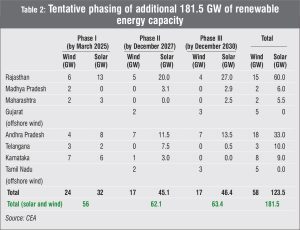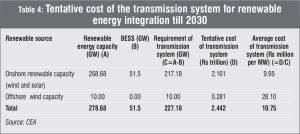India aims to increase the non-fossil fuel-based installed capacity to 500 GW by 2030. As of October 31, 2022, the installed capacity in the country stood at 409 GW, including 166 GW of renewable capacity (including large hydro), which is about 40 per cent of the total installed capacity.
To evacuate the power generated to the load centres which have high solar and wind energy potential need to be connected to the interstate transmission system (ISTS). The transmission system has to be planned in advance as the gestation period of wind- and solar-based generation projects is much less than the gestation period of the associated transmission system. To this end, the Central Electricity Authority (CEA) has released a report, “Transmission System for Integration of over 500 GW RE Capacity by 2030”. In the report, the transmission system has been planned for about 537 GW of renewable energy capacity (Table 1). Renewable Watch provides a brief extract from the report…

In the report, the transmission system has been planned for major renewable energy potential zones including Leh renewable energy park in Ladakh; Fatehgarh, Bhadla, Bikaner in Rajasthan; Khavda renewable energy park in Gujarat; Anantapur and Kurnool renewable energy zones in Andhra Pradesh; and offshore wind farms in Tamil Nadu and Gujarat. The installed renewable energy capacity target of 175 GW by 2022 comprises 66.5 GW of renewable capacity to be connected to the ISTS network. Part of the transmission system for this capacity has been commissioned (12.9 GW) and the rest is under construction (19.1 GW, slated for commissioning between December 2022 and November 2023), under tendering (8 GW), to be taken up for bidding (10.5 GW) and at various stages of planning.
In addition to the 66.5 GW capacity, the transmission system has been planned for 236.58 GW of renewable energy capacity. Of this, 181.5 GW is in the additional renewable energy potential zones identified for development by 2030. These zones are located in eight states (Table 2). Of the 181.5 GW capacity, 56 GW, 62.1 GW and 63.4 GW are likely to be commissioned by March 2025, December 2027 and December 2030 respectively. Of the transmission schemes planned for 181.5 GW of capacity, the transmission schemes for Bikaner II and Bikaner III renewable energy zones in Rajasthan; Koppal II and Gadag II renewable energy zones in Karnataka; and Kallam in Maharashtra have already been recommended by the NCT. These transmission schemes will be taken up for bidding. Subsequently, the transmission schemes for other potential zones will be taken up. The report mentions that in Rajasthan, of the total 75 GW of identified renewable energy potential zones, 45 GW (30 GW solar and 15 GW wind) lie in the Great Indian Bustard area in Barmer, Jaisalmer and Jodhpur districts.

The transmission schemes have been planned considering energy storage, so as to meet the requirement of round-the-clock (RTC) power. Several HVDC transmission corridors have also been planned for the evacuation of power from large renewable energy potential zones. It has been estimated that 50,890 ckt. km and 433,575 MVA is the additional requirement of transmission lines and substation capacity respectively, planned under the ISTS for integrating additional wind and solar capacity by 2030. The capacity-wise tentative additional ckt. km and MVA capacity are provided in Table 3.

The tentative cost of the ISTS network for integrating 10 GW of offshore wind capacity and other wind and solar capacity is Rs 281 billion and Rs 2.161 trillion respectively. The total cost of the planned transmission infrastructure is Rs 2.442 trillion (Table 4). The present interregional transmission capacity stands at 112,250 MW. With the additional interregional transmission corridors under implementation/planned, the cumulative interregional transmission capacity is likely to be about 150,000 MW in 2030.

Going forward, for the development of the planned transmission schemes, the government may provide some central financial assistance and low-cost financing from multilateral agencies in line with the Green Energy Corridors (GEC) scheme. Under the GEC-I scheme, about 24 GW of renewable energy capacity was planned to be integrated with the intra-state network, of which about 7 GW is to be commissioned by March 2023.
Outlook
Post the launch of the report, some industry observers have expressed reservations over its successful implementation given the right-of-way issues that continue to exist, leading to project delays and cost overruns. According to some, aggressive bidding for transmission projects makes such projects unviable. Some stakeholders have an interesting observation. While the government aims to deploy 30 GW of offshore wind capacity by 2030, the report plans for 10 GW of offshore wind capacity (5 GW each for Gujarat and Tamil Nadu).
However, despite these reservations, the release of the detailed report on transmission infrastructure for evacuation of renewables is a positive development given that this has been seen as a major hurdle in scaling up renewables. The gestation period of transmission projects is typically much longer than that of renewable energy projects, leading to delays in the commissioning of solar and wind assets, bid postponements and, in some cases, stranded assets. Thus, this report provides the much-needed roadmap for transmission capacity development, which will help transport the targeted solar and wind power to load centres and bring the country closer to its clean energy mix goals.



